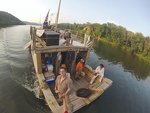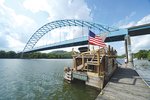Rinker Buck seems like a guy you could sit down and have a beer and a good chat with.The simplest conversation quickly turns into a master class of storytelling in short form. He knows everyone. He's …
This item is available in full to subscribers.
Please log in to continue |





Rinker Buck seems like a guy you could sit down and have a beer and a good chat with.
The simplest conversation quickly turns into a master class of storytelling in short form. He knows everyone. He's been everywhere. And he's wicked funny.
So, when Buck says he's going to build a wooden flatboat and challenge the mighty Mississippi, it would be hard to turn down an invitation to come along.
That's exactly what the history buff, long-time journalist and celebrated New York Times bestselling author did. And even if you weren't lucky enough to be among the sometimes-quirky crew to travel the 2,000 miles of treacherous waters over four months, you can still take the journey.
Buck has documented the adventure in "Life on the Mississippi," an epic tale told with wit, wisdom and heart-touching honesty. The book comes on the heels of Buck's best-selling adventure, "The Oregon Trail." Yes, he followed the legendary, 2,000-mile journey via covered wagon with a team of mules.
It was after that trek that Buck says he learned the Oregon Trail isn't what moved most of the early settlers across the continent. Instead, it was the landscape's waterways.
"We confronted so many rivers on the Oregon Trail. In one of the local histories, I read that most pioneers had really good river skills because they all descended from people who initially came west during the flatboat era, that was something they didn't teach in school," Buck said.
As it turns out, between the U.S. Revolutionary War and the U.S. Civil War about 3 million American pioneers and entrepreneurs navigated the Ohio and Mississippi River valleys. That was a huge number, Buck stresses, considering the population of the nation was only about 20 million at the time.
"By comparison only 500,000 crossed on the dusty plains in covered wagons. The Mississippi was the frontier for the first 50 to 60 years of the 19th century. It was a surprise to me," he said.
Flatboats have all but disappeared from nautical logs in present-day America. Their distant modern cousin, the houseboat, is similarly built but not used in the same manner. Buck built his flatboat, "The Patience," in Pennsylvania, headed down the Ohio River, hooked a left at Cairo, Illinois and headed for New Orleans, 1,000 miles downstream.
Over the four-month journey the crew encountered just four private pleasure boats, the rest were working commercial vessels, large hulking tugs that pushed dozens of barges at a time. Mix that with the fierce currents that are a hallmark of the mighty Mississippi and Buck was in for a treacherous ride.
Buck said he knows a lot of people will not understand his need to challenge the Mississippi.
"It is hard to explain to people the sense of adventure and obsession that journalists and writers have to provide information," he said. "Yes, it's dangerous. I say take the adventure but proceed with caution.
"I am driven by history. It's very important to tell what it was like on the rivers in the early years," he said. "To actually ride the rivers and encounter a dangerous water space like the Mississippi, I can't explain to other people that it makes sense. They look at you like you're nuts."
The river is maintained by the Army Corps of Engineers for the benefit of commercial navigation. Buck said half of the nation's goods flow down those waters each year to New Orleans where they are exported.
Across the river's entire distance there are just a handful of marinas to fill up on gas, a problem Buck solved by bringing along an electric bike to haul over the levies and ride into town in search of fuel. And those levies? They are tall to prevent the water from flooding onto the land and lined with sharp rock to prevent the land from eroding into the water.
"So, the irony is that one of our greatest national treasures is not maintained for the benefit of the public, so most people don't even see the Mississippi," he said.
Buck added that leaders in cities that sit on the river, such as Baton Rouge and Vicksburg, could do more to provide public access to the water and fight for a place among the commercial waterways the federal government has carved out of the natural wonder.
"We should care. There are very large, long tracts of both protected forest and wildlife refuges that help the public, but everybody can't get to them," he said. "We should make the river more accessible. Maybe this book will engender more interest in that."
What the book will certainly do is give readers an up-close look at the waters so few of us see. In the reflection of the waves, Buck even sees us.
He tells the story of a sheriff in Ohio who came down to the boat and asked if the crew had guns. They did not. He warned them that the kids in the projects in nearby Cincinnati would come storming out and attack the crew. They didn't.
In Baton Rouge, some kids approached the crew and also asked if they had guns. The kids told them that people in "Cajun Country" where the boat was headed would coming storming out and attack the crew. They didn't.
"These two diametrically opposed groups agree about something, guns," Buck said. "It is a valuable lesson in how our country thinks and moves and, interestingly enough, those people encouraging us to be armed, they weren't talking about guns. They were talking about fear."
You can hear Buck speak Wednesday, Aug. 10 at 7 p.m. at Page and Palette, located at 32 S. Section Street in Fairhope.